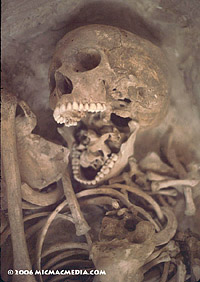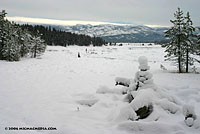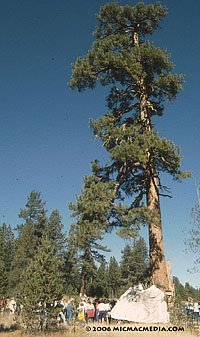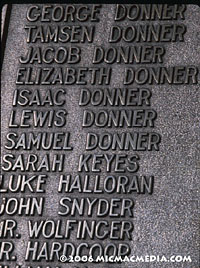 |
|
|
Follow Mark on Facebook for more stories |
||
|
Donner Party: Bones of Contention
Two days before the symposium, the lead scientists involved in this group effort released preliminary data from recent archeology at one of the winter encampment sites. Indicative of the hyperbole that always seems to accompany anything related to the Donner Party, their research results led to a nationally published Associated Press story with headlines like "Findings say Donner Party didn't resort to cannibalism" and "Lack of cooked bones at campsite a surprise." The real story is that an analysis of a very small sampling of tiny bone fragments from the Alder Creek location (only 30 out of nearly 16,000 pieces) did not turn up any human bones, which is important, but does not prove definitively that the snowbound pioneers there did not resort to cannibalism. The scientists involved in this on-going study made no such conclusive claims, yet the media headlines did, setting the stage for more confusion and misinformation, a problem which has plagued descendents and historians for nearly 160 years.
Archeological research at the Donner encampments has been an ongoing process. A co-leader of the forensic research team is Kelly Dixon, an assistant professor of anthropology at the University of Montana, who specializes in historical archeology of the American West. Dixon and her colleagues are following the work of professor Donald Hardesty, a University of Nevada-Reno anthropologist who led excavations at the Donner encampments in the 1980s and 1990s. At that time Hardesty proved that members of the Donner-led wagon train did camp at the east end of the lake. (The pioneers became separated upon their approach to the mountains and set up survival camps at different locations, best known as Donner Lake and Alder Creek.) In the early 1990s, Dr. Hardesty excavated the ground at the base of the iconic "Donner tree" at Alder Creek, about six miles north of Donner Lake, but found little evidence that any pioneers had camped there for a prolonged period of time. The lack of artifacts forced historians and the Forest Service to acknowledge that the revered tree did not indicate the location of the Donner campsite. Hardesty's frustrated crew expanded the search area and with the help of a metal detector survey soon discovered 19th century human artifacts about 200 yards away from the tree. Unfortunately, the project ran out of time and money before Hardesty could pursue the new leads, but his extensive research resulted in the book "The Archeology of the Donner Party," published in 1997 by the University of Nevada Press.
During the recent Alder Creek digs, the team discovered the remains of a hearth, a very important find, as well as fire-cracked rock, pipe bowl fragments, tiny pieces of bone, including charred bone, lead balls and ceramic fragments. The artifacts were dated to the appropriate time period and the evidence of a fire hearth led the scientists to conclude that this indeed was most likely a Donner family campsite. Dr. Hardesty said, "This absolutely adds more credibility to the interpretation that this is where the Donner families camped," he said. "The artifacts they found are similar to what we found in 1990 and 1993." New forensic technologies may lead the researchers into breakthrough territory. Schablitsky notes "Ten years ago, we didn't have the technology we have today. Ground-penetrating radar wasn't common and DNA analysis wasn't being used for archeology. We can do so much more now."
There are limitations, however, to what the new skills and equipment can reveal. Nearly 16,000 bone fragments were recovered from the Alder Creek location, although virtually all of them are smaller than a fingernail in size. All of the pieces have suffered environmental degradation and many are too small to study effectively with current technologies. DNA analysis is unavailable due to the breakdown of the bone material due to temperature extremes, soil acidity, and a climate pattern of very wet and very dry conditions (winter vs. summer) at the site. Scientists used scanning electron microscopes to study 30 of the larger pieces in a search for human bones that had been boiled (pot polish), an indicator of cannibalism. They were able to identify bones from horses, oxen, deer and dog, as well as rabbits and rodents, but no human bones were identified. The variety of animal bones at the Alder Creek campsite does suggest that the stranded pioneers there may have had more food available than previously thought. The anthropologists admit that based on the accounts that they had read, they definitely expected to find human remains among the animal bones, but to claim that no cannibalism occurred at the Alder Creek site based on these results is a conclusion that some find premature. Perhaps Jack McShane, a University of Montana graduate student and member of the Alder Creek research team, best summed up where we stand now: "Historically it's been said people resorted to cannibalism, but it's yet to be proven through archeology. It's possible that cannibalism [at Alder Creek] never happened." |
|||||||||||||||||||||||
|




